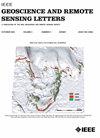基于相似时间序列干涉像元的持续散射识别和视角误差估计
IF 4
3区 地球科学
Q2 ENGINEERING, ELECTRICAL & ELECTRONIC
引用次数: 6
摘要
持久散射(PS)像素包含高度相干的信息,用于估计感兴趣的地球物理参数。通常,PS像素的选择是基于空间不相关相位分量中存在的估计噪声以及视角误差。对所选PS像素的相位历史进行角度误差校正,然后进行相位展开和提取空间相关的干扰相位分量,从而进行位移估计。在这篇文章中,提出了一种新的PS选择方法,该方法基于一个新的指标,称为相似时间序列干涉像元(STIPs),表示具有相似相位历史的邻域像元的数量。在该方法中,除了PS选择外,还使用相应的STIP集来改进视角误差估计。针对印度贾坎德邦Rajmahal的Sentinel-1A单视复杂图像,证明了所提出的InSAR处理链的效率,主要是煤矿地区。结果表明,与传统的PS处理技术相比,在提取更多可靠的PS和增强的密度方面有了实质性的改进。本文章由计算机程序翻译,如有差异,请以英文原文为准。
Persistent Scatter Identification and Look-Angle Error Estimation Using Similar Time-Series Interferometric Pixels
Persistent scatterer (PS) pixels contain highly coherent information, which is used in the estimation of geophysical parameters of interest. Conventionally, PS pixels are selected on the basis of the estimated noise present in the spatially uncorrelated phase component along with look-angle error. The phase history of selected PS pixels is corrected for the look-angle error followed by phase unwrapping and extraction of spatially correlated nuisance phase component leading to displacement estimation. In this letter, a novel PS selection method, which is based on a new index called the similar time-series interferometric pixels (STIPs) representing the number of neighborhood pixels with similar phase history, is proposed. In this approach, apart from PS selection, corresponding set of STIP is also used in refining look-angle error estimation. The efficiency of the proposed InSAR processing chain is demonstrated for the Sentinel-1A single look complex images of Rajmahal, Jharkhand, India, predominantly a coal mines area. Results, when compared with the conventional PS processing technique, reveal substantial improvement in terms of extracting more number of reliable PS with enhanced density.
求助全文
通过发布文献求助,成功后即可免费获取论文全文。
去求助
来源期刊

IEEE Geoscience and Remote Sensing Letters
工程技术-地球化学与地球物理
CiteScore
7.60
自引率
12.50%
发文量
1113
审稿时长
3.4 months
期刊介绍:
IEEE Geoscience and Remote Sensing Letters (GRSL) is a monthly publication for short papers (maximum length 5 pages) addressing new ideas and formative concepts in remote sensing as well as important new and timely results and concepts. Papers should relate to the theory, concepts and techniques of science and engineering as applied to sensing the earth, oceans, atmosphere, and space, and the processing, interpretation, and dissemination of this information. The technical content of papers must be both new and significant. Experimental data must be complete and include sufficient description of experimental apparatus, methods, and relevant experimental conditions. GRSL encourages the incorporation of "extended objects" or "multimedia" such as animations to enhance the shorter papers.
 求助内容:
求助内容: 应助结果提醒方式:
应助结果提醒方式:


